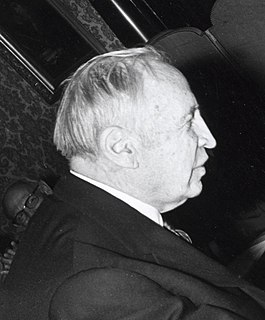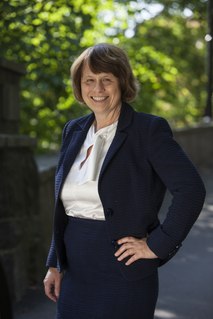Related Research Articles

Aage Niels Bohr was a Danish nuclear physicist who shared the Nobel Prize in Physics in 1975 with Ben Mottelson and James Rainwater "for the discovery of the connection between collective motion and particle motion in atomic nuclei and the development of the theory of the structure of the atomic nucleus based on this connection". Starting from Rainwater's concept of an irregular-shaped liquid drop model of the nucleus, Bohr and Mottelson developed a detailed theory that was in close agreement with experiments.

Niels Henrik David Bohr was a Danish physicist who made foundational contributions to understanding atomic structure and quantum theory, for which he received the Nobel Prize in Physics in 1922. Bohr was also a philosopher and a promoter of scientific research.

The Niels Bohr Institute is a research institute of the University of Copenhagen. The research of the institute spans astronomy, geophysics, nanotechnology, particle physics, quantum mechanics and biophysics.

Sandra Moore Faber is an American astrophysicist known for her research on the evolution of galaxies. She is the University Professor of Astronomy and Astrophysics at the University of California, Santa Cruz, and works at the Lick Observatory. She has made discoveries linking the brightness of galaxies to the speed of stars within them and was the co-discoverer of the Faber–Jackson relation. Faber was also instrumental in designing the Keck telescopes in Hawaii.

Ben Roy Mottelson was an American-Danish nuclear physicist. He won the 1975 Nobel Prize in Physics for his work on the non-spherical geometry of atomic nuclei.

John Hasbrouck Van Vleck was an American physicist and mathematician. He was co-awarded the Nobel Prize in Physics in 1977, for his contributions to the understanding of the behavior of electronic magnetism in solids.

Geoffrey Ronald Burbidge FRS (24 September 1925 – 26 January 2010) was an English astronomy professor and theoretical astrophysicist, most recently at the University of California, San Diego. He was married to astrophysicist Margaret Burbidge and was one of the authors of the influential B2FH paper.

Alain Aspect is a French physicist noted for his experimental work on quantum entanglement.

David Allan Bromley was a Canadian-American physicist, academic administrator and science advisor to American president George H. W. Bush. His field of research was the study of low-energy nuclear reactions and structure using heavy ion beams.

Ewine Fleur van Dishoeck is a Dutch astronomer and chemist. She is Professor of Molecular Astrophysics at Leiden Observatory, and served as the President of the International Astronomical Union (2018–2021) and a co-editor of the Annual Review of Astronomy and Astrophysics (2012–present). She is one of the pioneers of astrochemistry, and her research is aimed at determination of the structure of cosmic objects using their molecular spectra.

The Michael Faraday Medal and Prize is a gold medal awarded annually by the Institute of Physics in experimental physics. The award is made "for outstanding and sustained contributions to experimental physics." The medal is accompanied by a prize of £1000 and a certificate.

Alexander Dalgarno FRS was a British physicist who was a Phillips Professor of Astronomy at Harvard University.

Floyd Dunn was an American electrical engineer who made contributions to all aspects of the interaction of ultrasound and biological media. Dr. Dunn was a member of Scientific Committee 66 of the National Council on Radiation Protection and Measurements as well as many FDA, NIH, AIUM, and ASA committees. He collaborated with scientists in the UK, Japan, China and Post-Soviet states.

Jens Kehlet Nørskov is the Villum Kann Rasmussen professor at the Technical University of Denmark. He is a Danish physicist most notable for his work on theoretical description of surfaces, catalysis, materials, nanostructures, and biomolecules.
Pierre Aigrain was a French physicist and Secretary of Research in the French Academy of Sciences.
The Bohr family is a Danish family of scientists, scholars and amateur sportsmen.
The Maria Goeppert-Mayer Award is an annual prize presented by the American Physical Society in recognition of an outstanding contribution to physics research by a woman. It recognizes and enhances outstanding achievements by women physicists in the early years of their careers.
The UNESCO Niels Bohr Medal was first minted in 1985 to commemorate the 100th anniversary of the birth of the Danish nuclear physicist Niels Bohr. It is awarded by UNESCO to recognise those who have made outstanding contributions to physics through research that has or could have a significant influence on the world.

John Simpson is a British nuclear physicist. He is known for his work in gamma-ray spectroscopy and detector design. He was Head of Technology, Division of Technology Department. and was Head of the Nuclear Physics Group at STFC Daresbury Laboratory. He is a visiting professor of physics at the University of Liverpool.
References
- 1 2 "French physicist receives the Niels Bohr Medal". University of Copenhagen. Archived from the original on 6 October 2013. Retrieved 3 December 2013.
- ↑ "Previous Winners". Københavns Universitet. Retrieved 14 September 2020.
- ↑ "First Niels Bohr Medal for Dane since 1955" . Retrieved 21 September 2018.
- ↑ "Ewine van Dishoeck receives Niels Bohr International Gold Medal". www.mpe.mpg.de. 7 October 2022.